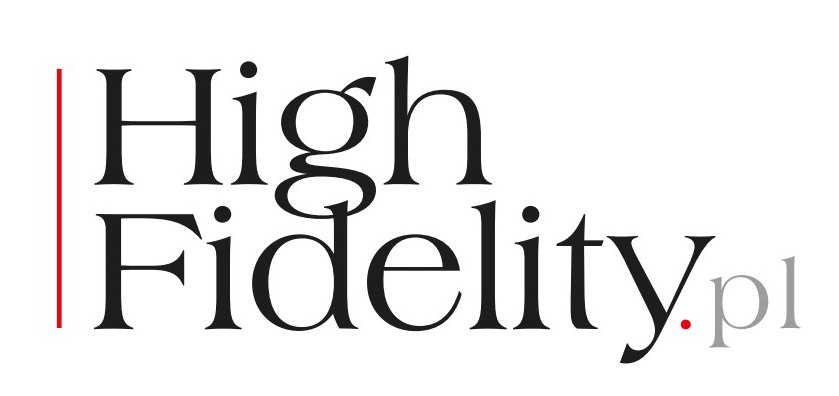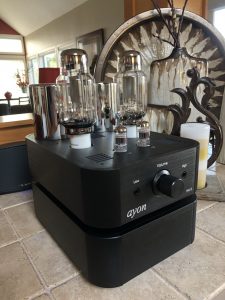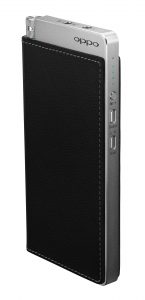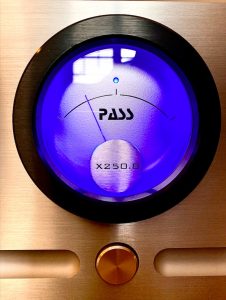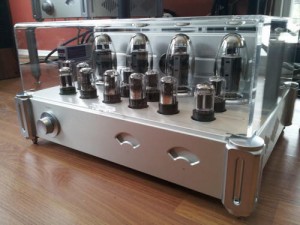It so happened that together with some friends we delivered the Audio Tekne system I reviewed before directly to the Audio Video Show 2015. As soon as we finished carrying all those damn heavy devices to the exhibition room Hari (from Natural Sound) told us the good news—next we would get the top Audio System for review. To be perfectly honest my feelings were... ambivalent at first. Sure, a perspective of few weeks with probably one of the best systems there are felt great and exciting. Having reviewed already two smaller AT systems I was fully aware that I was to be in music lover's heaven through all that time. But on the other hand since my back still hurt from carrying not the heaviest AT system, remembering that the top phonostage was a two box (monoblock) design weighting 63kg each I also realized what a challenge it would be to get them to my room. But hey, we, audiophiles, are crazy, right, we would do anything for a good sound. So yeah, I knew I wouldn't be able to resist Hari's offer.
Some day, beginning December it happened—the already known to me from the previous test top linestage TFA 9501, top power amplifiers TM 9502 and most likely (I did not do proper research about it) the biggest and heaviest phonostage on planet Earth, TEA 9501, landed in my room. Those of you who visited Natural Sound room during last AVS, or Munich's HiFi Delux Show 2015 had a chance to see these monsters. Yes, monsters, plural as these are monoblocks and each of the weights 63 kg and measures 75 cm on its longest side (width or depth, depending on how one places them). So yes—a phonostage weighting 126 kg altogether despite the fact that it is powered from TFA 9501 linestage.
To place both channels of said phonostage one need a shelf measuring at least 50 x 75 cm, capable of supporting this kind of weight too. Surely not all of you read my previous review of AT system so let me explain that the preamplifier TFA 9501 is an obligatory partner for this phonostage as it contains a power supply for the top phono. There is no other way to power up TEA 9501. One could use preamplifier alone of course, but phonostage must be paired with this pre, period.
There is a big red button on the front of linestage that turns the phonostage power supply section on. When phonostage is not used user can leave this section off. The TFA 9501 is a top of the line preamplifier in Mr Imai's range. It features an interesting volume control system that has a clear advantage over the one used in integrated amplifier I started my AudioTekne reviews with. The volume control in this integrated wasn't were precise so it was quite a challenge to set required level. Actually the biggest problem was setting a low enough level for night listening sessions.
This preamplifier features two attenuators—one 'standard' one, meaning that it is used for adjusting level of output signal, and the second one that allows user to attenuate input signal. This might not be the most handy volume control I've seen, even more so because there is no remote control, but it is precise, and it ensures proper sound quality level required by Mr Imai. One easily gets used to using two knobs instead of one although when one needs to mute the sound quickly it is easier to user input selector.
Last element of this systems are top Audio Tekne power amplifiers, TM 9502 based on Mr Imai's favorite power tube, 6AS7G working in push-pull configuration. Just as almost all AT amplifiers (there is only one exception I know of) also this one delivers relatively low output power (11 W). In other words they require high-efficiency, easy to drive loudspeakers as their partners. Soon Natural Sound will offer new versions of American high-efficiency speakers by dc10Audio and Japanese Maxonic that most likely will be perfect partners for AT systems. But for now I had to settle on my trusted Bastanis Matterhorn . I couldn't resist the urge and partnered AT system also with remarkable Ubiq Audio Model One at least for a short time.
SOUND
Records used for the test (a selection):
- AC/DC, Highway to hell, EMI SVLP 325, LP.
- Arne Domnerus, Jazz at the Pawnshop, Proprius ATR 003, LP.
- Cannonball Adderley, Somethin' else, Classic Records BST 1595-45, LP.
- Dead Can Dance, Spiritchaser, 4AD/Mobile Fidelity MOFI 2-002, LP.
- Dżem, Detox, DZEM SC 001/91, LP.
- Georges Bizet, Carmen, RCA Red Seal SPA 25 064-R/1-3, LP.
- John Williams, Star Wars, 20th Century Records STEC 264/65, LP.
- Keith Jarrett, The Köln Concert, ECM 1064/65 ST, LP.
- Lou Donaldson, LD+3, Blue Note MMBST-84012, LP.
- Miles Davis, Kind of Blue, COLUMBIA CS 8163, LP.
- Milt Jackson/Ray Brown, It don't mean a thing if you can't tap your foot to it, Pablo Records 2310-909, LP.
- Mozart, Cosi Fan Tutte, Teodor Currentzis conducting MusicAeterna Orchestra, Sony Classical B00O1AZGD6, LP.
- Muddy Waters & The Rolling Stones, Live At The Checkerboard Lounge. Chicago 1981, Eagle Rock Entertainment B0085KGHI6, LP.
- Patricia Barber, Companion, Premonition/Mobile Fidelity MFSL 2-45003, 180 g LP.
- Pink Floyd, The Endless River, Parlophone Records 825646215478, LP.
- Vivaldi, Le Quatro Stagioni, Divox/Cisco CLP7057, LP.
This time I started my session with pre + monos combo receiving signal not from AT phonostage but from digital sources—my Lampizator Big 7 and Leema Acoustics Libra. This time the first quality of this presentation that caught my ear was a huge soundstage, that combined with amazing resolution of the sound allowed me to enjoy an amazingly precise render of Michał Miśkiewicz's brushes dancing on cymbals and drums of his percussion on the album Trio. Each strike whether on cymbal or drum had outstanding clarity so even during fast passages it was still a series of fast sounds and not a constant noise, if you know what I mean.
Precision of the whole soundstage and localization of each sound was truly amazing—I could 'see' the whole drum set set up in the space, I could see drummer turning around to play this or that cymbal/drum, I could clearly hear where the sound was coming from. Also clarity of cymbals tones was remarkable and a nice, long decay followed each sound. Listening to many different recordings I paid special attention to the decay phase of sounds and if this phase was properly recorded Audio Tekne never cut it short. But I enjoyed not only cymbals but also drums—each strike had this outstanding immediacy, was fast, taut, very convincing. Also differentiation was great taking this performance on (almost) live like level that only few powerful solid state amps I reviewed could match.
Yes, I was amazed by drums performance because that was bit unexpected from 11W tube amplifiers, but double bass and piano sounded also amazing. These instruments also had a large, full body and proper 'weight'. Both impressed with dynamics, vibrancy and wonderful timbre—it was a top performance and I mean of both, the band and this remarkable system.
Equally precise was spacial localization of musicians on Al Di Meola's All your life and on brilliant Friday Night in San Francisco. Guitars, especially acoustic one, belong to my favorites, and here I felt like I could just go there and touch each musician, each instrument. Just in case that somehow you never heard Friday night... it's a live performance of three absolutely brilliant guitarist, the late Paco de Lucia, Al Di Meola and John McLaughlin. Some tracks are played by all three of them, some by two. I must have listened to this album hundred times at least and was still amazed this time by how easy it was to say where which of them sat, how far from the others, and of course (based on style and different sound of each guitar) which is actually playing. Audio Tekne's presentation kept me on my toes despite the fact that I knew what would happen in a moment. And yet it was still exciting to wait for Paco to start paying, and now John, yeah go Al, go... That's so much more than just listening to music, that's what our hobby is truly about—experiencing music at home in a way we can't (at the moment or at all) experience it live (because we can't spend live attending concerts).
Roy Hargrove's album (thank you Marek for a tip!) offered another wonderful, musical experience. Kick drum again had this immediacy and... well—kick, cymbals were wonderfully vibrant, fast and their sound sent made the air in my room vibrate. But what swept me of my feet was breathtaking performance of brass instrument. I simply had to pump up the volume to not only hear but also feel this incredible energy, I mean the one you can physically feel while attending a live concert while being really close to the stage. Trumpet was sharp, able to sting an ear but never going beyond pain threshold (which never happens when you listen to a trumpet live but it does happen on some systems). I think it was also while listening to this album that I finally realized how rich, dense sound Audio Tekne system offered. And I mean in this respect it outperformed almost all other systems I know. Trumpet might have sounded 'sharp' but its sound had proper weight, and was amazingly rich, too,
I played, one of the older albums by Marcus Miller, Renaissance, to confirm what I already knew. The top Audio Tekne system amazed with its dynamic and presented bass, both acoustic (which many top quality tube amplifiers do) and electric, in the most remarkable way. Also this time playing Marcus' album reminded me of his recent Warsaw concert. The only regret was that AT monos offered only 2x11W which meant I couldn't use them with Ubiq Audio Model One. I knew that if to these amazing dynamic abilities of Audio Tekne I could add this extraordinary quality of Slovenian speakers of conveying an energy of live music the way they do, it would create even more spectacular, more live-like presentation. Matterhorns couldn't convey that much energy but they amazed me again with level of performance they offered despite the fact of being relatively (comparing to AT) cheap. I knew they could perform damn well—each time I thought they would be clearly the weakest link in a system with Kondo, Robert Koda or Audio Tekne amplifiers, they delivered outstanding performance doing their best to keep up, not to spoil the pleasure of listening to such remarkable amps.
And they didn't let me down this time either, despite the fact that for their price I could maybe buy these carbon feet of AT amps 🙂 Sound was very rich, dense, powerful, rhythm was almost perfect too—almost was obviously a limitation of speakers and not of electronics. The last album by Lee Ritenour, A twist of rit proved how fantastic an electric guitar sounded on the reviewed system—owerful with drive when needed, and very smoothly and refined on other tracks—regardless of tracks 'climate' presentation was very realistic each time. Obviously, since we're talking about electric instrument in a studio recording, realism is relative, but I heard many guitars in my live playing live, I even played a bit myself back in the day, so I might say that I know how an electric guitar sounds like. And yes, Audio Tekne system brought Lee and his band to my room and had them play just for me....
My initial assumption was that I would use digital sources only for a short while and then move to analogue rig. But the system sounded so well already with digital sources that I spent with them few days before finally moving to the Raven Black Night with Koetsu Rosewood Signature Platinum, (later replaced also with my Air Tight PC-3). I placed the first record on the platter, let stylus drop in the groove and... and that's when the real magic began. This first album was Dark side of the Moon starting with this powerful pulse and later developing in one of the best pieces of rock music ever created. With digital source sound was already great, so how could I even describe what happened now. Well—it was pure magic!
It felt like before it was all great but only because I did not realize that there was still a piece missing to make it all perfect. Now it was there, it all just clicked and even though I couldn't really tell what exactly got even better I simply knew IT WAS IT! Beautifully rich, powerful, liquid and coherent sound with a thunderous bass that never dominated rest of the range though, with sparking, breathing, open treble, and remarkably colorful mids. Sound was 'crazy' rich but also very transparent, detailed, crystal clear, intense, energetic but also subtle and refined.
Phonostage delivered also differences between cartridges just out right. It was obvious to me which changes AirTight introduced after Koetsu but these differences were only a small part of all the information delivered, something I noticed but didn't care much about, as in both cases I enjoyed music first of all. Koetsu delivered bit more rounded sound in both, bass and treble area, an incredibly dense midrange which added on top of the same quality of the AT system. Air Tight delivered more flat, better balanced sound throughout the whole range—so no rounding on both extremes but also rich but not as dense midrange. But again—it was more like a different taste of the same pure magic that Audio Tekne and Raven created regardless of which cartridge was used at particular moment. This setup created a fantastic in every aspect presentation, rich, particularly expressive and amazingly immersive. Before I had a breathtaking experience listening to Friday Night in San Francisco, or Jazz at the Pawnshop played from hi-res files, and now using vinyls I was even more impressed about how natural, organic and real this presentation got. I was so immersed in music that I actually felt like a participant of these concerts. There was even more wood in guitars sound, the decay phase seemed even longer and the whole ambiance of live performance including fun that both musicians and crowd listening to them obviously had was simply overwhelming—I felt like I was right there have as much fun as they had.
I spent all days listening to one records after another feeling a bit like a kid who found some super cool but long forgotten toys that still give him as much fun as they did years ago. If that's not what our hobby is about then I don't know what is. It should be a (constant) search for a system that makes us feel just like that—this Audio Tekne setup could surely be it for me!
Summary
After a spending few weeks with a system like THAT I can only say that I understand why people who can afford it would spend that much money to buy themselves such a unique experience. Because that's what it is really all about—about being able to experience the same sensation of a new discovery of particular piece of music again and again. It's not about discovering new details or subtleties on a well known records, but about being as exciting while placing a record on the platter, as one was during that very first time when one listened to this album for the first time. If you can feel the same excitement before listening to the same records for the 10th, 20th, or 50th time than you mean you have a remarkable, very rare setup. The one I reviewed here is surely one of very few existing that can provide its owner with this feeling.
It's like going to concerts of a favorite artist—they often play the same music but in a slightly different way—that's why we go to see them as often as we can. Even though I had AT system at home for a limited time I listened to some records few times and each time I was as excited before and as satisfied after as it would have been the first listen. During these 2 and half weeks I played La nozze di Figaro probably 6, maybe even 7 times (and that's a double album), Dark side of the Moon and Friday Night in San Francisco at least 3-4 time. And I was equally thrilled each and every time. Of course in the review I had to mention bass, midrange, transparency, richness and so on, but the fact is it did not matter at all while I experienced music. Time with Audio Tekne was a real feast for my mind, heart and soul—what more could I, or any other fan lover, want?
DESIGN
Just like in case of all other AudioTekne products information on these products provided by manufacturer are scarce. As all of them also these three use characteristic enclosures placed on carbon anti-vibration feet.
TFA 9501
Information provided on this top of the line preamplifier, TFA 9501, states that it uses double triodes 5965 or E180CC (either former or latter type). Altogether it uses 6 tubes. Just like in other products Mr. Imai makes, these tubes sport carbon anti-vibration "hats". To replace tubes one has to unscrew these pieces of carbon first. Tubes are placed in small spaces between six transformer housings. Transformers use SuperPermalloy cores (Ni79Fe15Mo5). An interesting thing about this design is that when used together with top of the line phonostage, TEA 9501, it acts as a power supply for it.
On the rear panel one finds additional power outlets that, when unused, are secured with metal caps. One uses these to deliver power to TEA 9501 (if used together—TEA 9501 can not be used without TFA 9501). On the front panel there is the main on/off switch with a red indicator light that come on when device is switched on. Next to it sits another big, backlit push-button that turns on and off power supply for phonostage. Next switch turns record out. There are also four gold knobs. Two of them, the one on the left and the one on the right side, allow user to control volume, two inner knobs act as input selectors (the right one allows to select phonostage, the left one all other inputs).
Rear panel sports XLR input and output, 5 linear inputs (RCA), Rec out, and RCA output (plus a small switch to select whether one uses RCA or XLR output). There is also IEC socket and above mentioned power outlets for external phonostage. This preamplifier an exclusive system of transformer sound attenuator called ATT: all transformers on the signal path use Super Permalloy cores, fixed bias, class A push-pull circuits.
TM 9502
The mono amplifier TM 9502 is a flagship in Audio Tekne range. It Is based on Mr Imai's favorite triode, 6AS7G and Permaloy transformers. It's a push-pull design delivering maximum output of 11 W. It features both, RCA and XLR inputs—a small toggle switch allows user to select one or the other. On the rear panel one finds inconspicuous speaker posts that in fact are quite clever, and an IEC socket. Front panel features a characteristic on/off switch with a red power on indicator.
TEA 9501
TEA 9501 is also a flagship product. In fact these are two monoblocks—one, separate for each channel, each weighting impressive 63 kg, despite the fact that the power supply is placed inside TFA 9501 linestage. These are particularly big devices measuring on the longest side 750mm which means one needs not only a sturdy surface that can withstand over 125kg weight, but also a big one. Phonostage works only with low signal MC cartridges with low and high impedance. The RIIA is implemented with the LC topology. Transformers feature cores made of Permaloy. The device sports both, RCA and XLR inputs and output. Just like in all Audio Tekne devices also here anti-vibration carbon elements were used.
Specifications (according to manufacturer):
TFA 9501
- Inputs: Phono, CD, Tuner, Tape, AV, Aux
- Maximum input signal: 3 V rms
- Outputs: Rec Out; Pre Out XLR and RCA
- Frequency range: 20 Hz-20 kHz (+/- 1 dB)
- Dimensions: 445 x 225 x 346 mm (W x H x D)
- Weight: 55 kg
TM-9502
- Inputs: RCA and XLR
- Input sensitivity/impedance: 1 V/3,3 kΩ
- Power output: 11 W
- Harmonic distortion: < 5%/11 W
- Frequency range: 10 Hz-20 kHz (- 1 dB/- 3 dB)
- Residual noise: < 1 mV/8 Ω
- Power consumption: 160 W
- Dimensions: 475 x 225 x 300 mm (W x H x D)
- Weight: 51 kg/pc.
TEA 9501
- Inputs: phono, only MC Low & High impedance
- Max input level: Phono Low 25 mV rms | Phono High 85 mV rms
- Output level: 1,6 V rms (std.) - 13 V rms (max)
- Outputs: XLR and RCA
- RIAA accuracy: +/- 1,5 dB (20 Hz-15 kHz)
- Power consumption: 70 W
- Dimensions: 750 x225 x 240 mm (W x H x D)
- Weight: 63 kg/pc.
Price (when reviewed): 69 000 + 89 000 + 155 000 euro
Audio Tekne Incorporated 596-4
Sanyu-town, Hachioji-city
Tokyo Japan 192-0012
www.audiotekne.com www.audiotekne.com
MADE IN JAPAN
Product provided for test by:
NATURAL SOUND s.r.o.
www.natural-sound.eu
Text: Marek Dyba
Images: Audio Tekne | Marek Dyba












